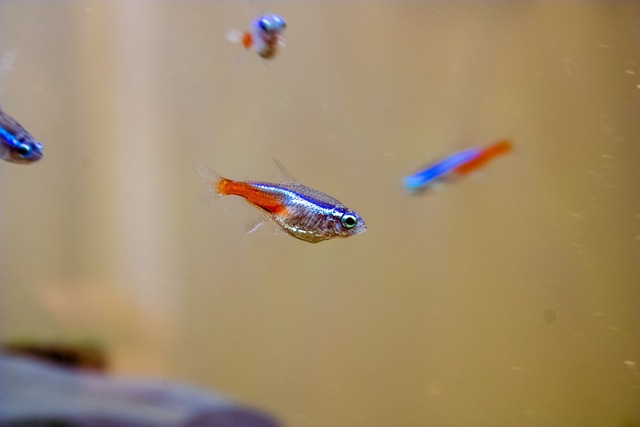Neon tetras are small, brightly colored fish popular among aquarium enthusiasts. While they are known for their active swimming behavior and tendency to stay near the top of the tank, many wonder if they also eat off the bottom.
This is an essential question for those who want to ensure their neon tetras get the proper nutrition they need to thrive.
There is some debate among fish experts about whether or not neon tetras eat off the bottom of the tank.
Some sources suggest that they primarily feed on insects and other small organisms that float near the water’s surface, while others argue that they will also consume food that has sunk to the bottom.
Understanding the feeding habits of neon tetras can help aquarium owners make informed decisions about what to feed their fish and how to keep them healthy and happy.
Diet of Neon Tetras
Neon tetras are small freshwater fish that are popular among aquarium enthusiasts. They are known for their vibrant colors and active behavior. However, proper nutrition is essential for the health and well-being of these fish.
What do Neon Tetras Eat?
Neon tetras are omnivores and will eat a variety of foods. They feed on small insects, crustaceans, and plant matter in the wild. In captivity, they can be fed a diet of live and prepared foods.
Some common types of food that neon tetras can eat include:
- Flakes or pellets specifically designed for small tropical fish
- Frozen or live brine shrimp
- Frozen or live daphnia
- Frozen or live bloodworms
- Vegetables such as peas or spinach
Do Neon Tetras Eat Off the Bottom?
Neon tetras are primarily mid-level feeders and will usually eat floating or suspended food in the water column. However, they may also eat food that has sunk to the bottom of the aquarium.
It is important to note that neon tetras are small fish and may have difficulty competing with larger, bottom-dwelling fish for food.
Feeding neon tetras in small amounts several times a day is recommended to ensure they are getting enough food.
How Often Should You Feed Neon Tetras?
Neon tetras should be fed in small amounts several times a day rather than one large feeding. This helps to prevent overfeeding and ensures that all fish in the aquarium have a chance to eat.
Generally, neon tetras should be fed no more than they can consume in about two minutes. Overfeeding can lead to health problems such as obesity and poor water quality.
In conclusion, neon tetras are omnivores and can eat various foods. They may eat food that has sunk to the bottom of the aquarium, but it is essential to feed them in small amounts several times a day to ensure they are getting enough food.
Feeding Neon Tetras
Neon tetras are small, colorful fish that are popular among aquarium enthusiasts. They are easy to care for and can thrive in most freshwater aquariums. However, one of the most important aspects of keeping neon tetras healthy is feeding them a nutritious diet.
Preparation of Food
When it comes to feeding neon tetras, choosing the right type of food is important. Neon tetras are omnivores, which means they eat plant and animal matter.
They prefer small, live foods such as brine shrimp, daphnia, and bloodworms. However, they will also eat high-quality flake and pellet foods.
Before feeding neon tetras, it is essential to prepare the food properly. Live foods should be rinsed thoroughly before feeding to remove dirt or debris.
Flake and pellet foods should be soaked in water for a few minutes before feeding to prevent them from expanding in the fish’s stomach.
Feeding Tips
When feeding neon tetras, they must have small, frequent meals throughout the day. This will help prevent overfeeding and keep the aquarium water clean.
A good rule of thumb is to feed neon tetras twice daily, in the morning and evening, with only as much food as they can consume in a few minutes.
It is also essential to vary the diet of neon tetras to ensure they receive all the necessary nutrients. This can be done by alternating between live and prepared foods or adding supplements to their diet.
Finally, observing the neon tetras while they are eating is essential. If food is left uneaten after a few minutes, it should be removed from the aquarium to prevent it from decomposing and polluting the water.
In conclusion, feeding neon tetras is a simple task requiring some preparation and attention. However, aquarium enthusiasts can ensure that their neon tetras remain healthy and happy by providing them with a varied and nutritious diet and monitoring their feeding habits.
Conclusion
In conclusion, neon tetras are primarily surface feeders that consume food that floats on the water’s surface. They are not bottom feeders and do not typically eat off the bottom of the tank. While they may occasionally eat sinking food, it is not their preferred feeding method.
It is important to note that neon tetras are small fish with small mouths, so their food should be appropriately sized. They also have a fast metabolism and require frequent feedings, but care should be taken not to overfeed them, as this can lead to health problems and poor water quality.
Overall, providing a varied diet that includes high-quality flakes and small, live, or frozen foods will help ensure neon tetras receive the proper nutrition they need to thrive. Fish keepers can help their neon tetras live long, healthy lives by understanding their feeding habits and providing appropriate food.









